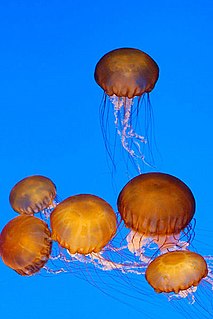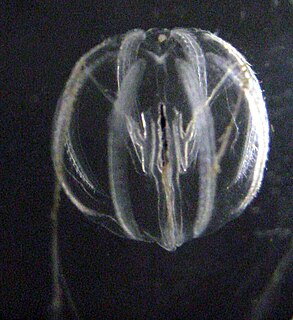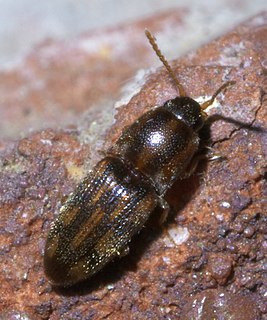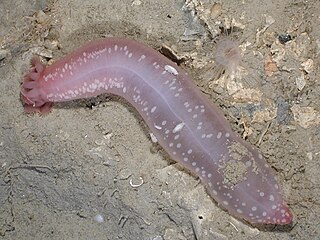
Johann Friedrich Gustav von Eschscholtz was a Baltic German physician, naturalist, and entomologist. He was one of the earliest scientific explorers of the Pacific region, making significant collections of flora and fauna in Alaska, California, and Hawaii.
Pyrophorus is a genus of click beetle. They are one of several genera in the tribe Pyrophorini, all of which are bioluminescent. Their bioluminescence is similar to that of another group of beetles, the fireflies, although click beetles do not flash, but remain constantly glowing. They have two luminescent spots at the posterior corners of the pronotum, and another brighter spot in the dorsal region of the abdomen. This spot is even brighter and can only be seen when in flight. Bioluminescent click beetles are found throughout tropical and subtropical America. Species from Texas, Florida, and Cuba are now in different genera in the tribe Pyrophorini, such as Deilelater.

Omus is a genus of tiger beetles, subfamily Cicindelinae. Its members are dark colored, nocturnal, and flightless. All members occur along the west coast of North America.

Chrysaora is a genus of jellyfish in the family Pelagiidae. The origin of the genus name Chrysaora lies in Greek mythology with Chrysaor, brother of Pegasus and son of Poseidon and Medusa. Translated, Chrysaor means "he who has a golden armament."

Denticollinae is a subfamily of beetle in the click beetle family. They occur in most regions of the world but are more abundant in cool temperate areas.

Pleurobrachia is a common genus of Ctenophora. Along with the genus Hormiphora, it generally has the common name sea gooseberry. It contains the following species:

Bolinopsidae is a family of ctenophores.

Ceroglossus is a genus of beetles in the family Carabidae, containing the following species: Members of this genus are restricted to Chile and Argentina.
Metrius is a genus of beetles in the family Carabidae, containing the following species:

Agalmatidae, or Agalmidae, is a family of siphonophores.

Cuninidae is a family of hydrozoans in the order Narcomedusae. They have dome-shaped bells and tentacles set above the undulating margin of the bell. Their gastric pouches contain the gonads situated in line with the tentacles, the number of pouches being the same as the number of tentacles. The pouches do not extend below the points of origin of the primary tentacles. Members of some genera have a peripheral canal system and others do not. No radial canals or secondary tentacles are present.

Apolemia is a genus of siphonophores. It is the only genus in the monotypic family Apolemiidae.

The cigar comb jellies, Beroespp., are members of a genus of comb jellies in the family Beroidae.

Passalus is a genus of beetles of the family Passalidae.
Cicindela altaica is a species of tiger beetle in the genus Cicindela. It was described by Eschscholtz in 1829 and is endemic to Altai Mountains in Russia.

Pelagia is a genus of jellyfishes in the family Pelagiidae. It is currently considered as monotypic with one species, Pelagia noctiluca(Forsskål, 1775).

Conoderus is a genus of click beetles in the family Elateridae. There are at least 30 described species in Conoderus. Species of Conoderus complete their development in one year.

Chiridota is a genus of sea cucumbers in the family Chiridotidae. It is an extant genus but some fossil species are known.

Aegina citrea is a genus of hydrozoans in the family Aeginidae.

Eirenidae is a family of hydrozoans.


















